|
|
|
|
|
Brigham Young High School History
|
|
|
|
The Rise & Fall of
Probert Hall
|
|
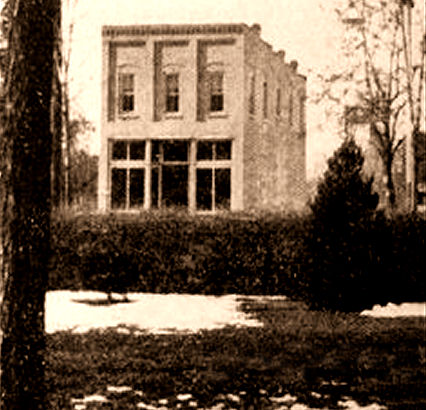
The Probert Hall building |
|
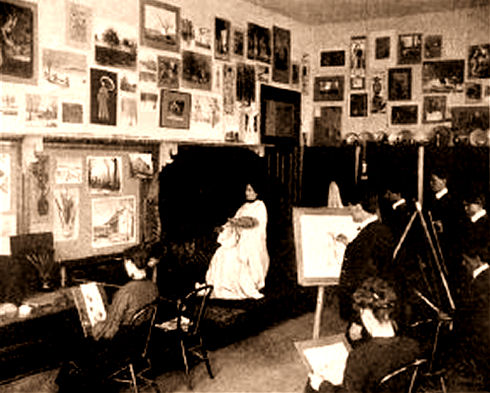
Interior of Probert Hall, art class in session. |
|
|
Almost every Brigham Young High School student in the twentieth century has visited the inside of Probert Hall for one reason or another.
During the 1960s, we visited the place whenever we wanted to eat Colonel Sanders' "finger-lickin' good" chicken for lunch or dinner.
Probert Hall, located across University Avenue on the corner just south of the Women's Gym, has also served in modern times as the home of a dairy outlet, several restaurants, and Calder's, a famous malt shop. Calder's was a popular student hangout in the fifties, and probably during the forties, too. Over the years, many students got their first jobs there.
Back in January of 1892, enrollment at Brigham Young Academy had increased dramatically because of the opening of the new Education Building. The job of finding adequate classroom space became a constant headache.
The Probert building, conveniently situated just across the avenue on the corner of Fifth North, was rented and remodeled for spillover classroom and laboratory purposes.
According to the Utah County Recorder's Office, Brigham Young University finally purchased this building on October 1, 1907, but for at least a dozen years before that, Probert Hall had been leased and used for school purposes.
|
|
The Brigham Young Academy Class of 1896 as it was photographed in 1893. Their chairs sit in the middle of a muddy Academy Avenue, squarely on the tracks of the Provo Street Railroad Company. Whether this is intended as a photographic pun about their class "being on the right track" or not, the group directly faces Probert Hall.
|
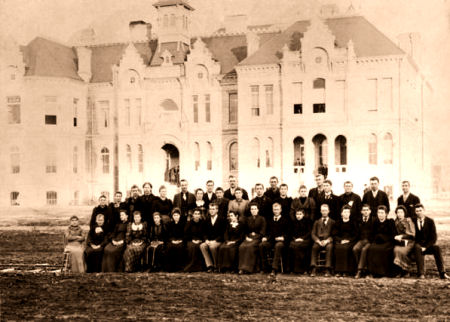
|
|
Classroom warmth and accidental fire were both a constant concern of the school, particularly since the Lewis Building conflagration in 1884. A member of the faculty was appointed to be responsible for the proper maintenance of campus facilities.
In 1894, faculty member Joseph B. Keeler was given the additional appointment as Custodian. Along with his teaching, he hired and supervised janitors and firemen to do the actual work of cleaning of rooms and firing the many coal stoves.
Probert Hall is first mentioned in the Brigham Young Academy faculty minutes on February 5, 1895, when it reads, “Custodian reported that the fireman could not attend properly to the fire [needs] in the Academy and the Probert Hall at the same time. The Custodian was instructed to secure another fireman.” The firemen employed were usually Academy students working their way through school.
During those years, Probert Hall served thousands of Brigham Young high school and college students who trooped across Academy Avenue, and after 1903, University Avenue, to attend their classes.
At times Probert Hall provided rooms for Physical Culture, the Millinery Department, and the Art Department. Art classes conducted in studios there included design, pen and ink drawing, watercolor, and oil painting. It is likely that many other types of classes were held there, too.
After it was purchased, the school began to refer to Probert Hall as the "Manual Arts Building".
In 1903, Brigham Young Academy ceased to exist. The school continued, but it was now divided into two closely linked educational institutions.
The first organization was the much larger Brigham Young University Training Schools with elementary grades, a middle school, and Brigham Young Senior High School.
The second institution was the fledgling Brigham Young University.
Both were operating on the same crowded one-city-block campus, with some spillover to buildings like Probert Hall.
Bolstered by a new vision of the school's future, and with the surprisingly effective leadership of Byron Owen Colton, a BYH/BYU student, BYU purchased 17 acres on Temple Hill from the City of Provo in February of 1904.
It was on the new "Upper Campus" that BYU would spread north and east for many decades, leaving BY High with more "elbowroom" on the old "Lower Campus".
In 1908, the Missionary and Preparatory departments of the school were discontinued, freeing up precious Lower Campus space. These departments had been operating in the new building located on the northwest corner. Remodeled for the Art Department, it was named the "Arts Building", and rededicated for its new use on January 16, 1908 by Apostle John Henry Smith.
Professor Elbert H. Eastmond reported the official relocation of the Art Department from the Probert Building to the Arts Building in the February 12, 1908 edition of the student newspaper, the White and Blue.
As the Upper Campus expanded, the need for spillover space on the Lower Campus decreased.
BYU sold Probert Hall, then known as the "old Arts Building", on September 7, 1912, to Oscar Hyde of Provo for $3,000.
|
|
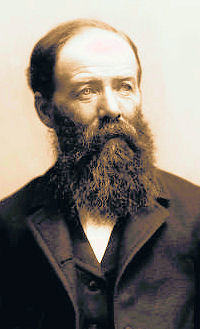
William Probert |
|
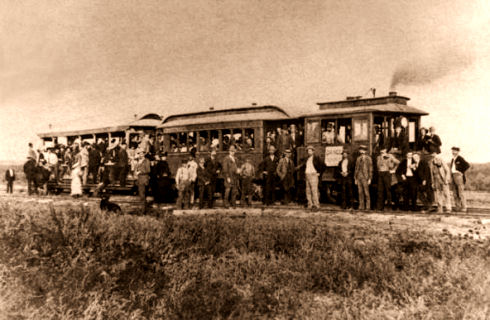
Puffing Billy, namesake of William Probert |
|
Why William Probert originally built this brick two-story storefront building is something of a mystery, but a few clues have survived.
In the 1890s, William Probert was the Superintendent of the Provo Street Railroad Company. This little railroad was built in 1889 and ran until 1896 up and down Academy Avenue, then out on Center Street to the Provo Resort on the shores of Utah Lake.
Pulled by a little steam engine named "Puffing Billy", it frequently frightened horses in the street, sometimes jumped its track, and was often was "stopped dead in its tracks" by errant cows.
The railroad's business boomed during the summers when Provo residents sought relief from the heat by relaxing on the shores of Utah Lake, but for the rest of the year business lagged, until after several years it was no longer financially feasible to continue.
It was during the life of the Provo Street Railroad Company that Mr. William Probert purchased the corner lot across the street from where the new Brigham Young Academy campus was to be built, and there Probert constructed his two-story brick store building.
It is likely that Mr. Probert saw a new business opportunity, where future Academy faculty and students would be regular customers, and also where the terminus or "wye" of his railroad would attract additional residents and visitors.
The building was apparently designed to serve as a passenger terminal, where refreshments and other goods could be purchased while people waited for the train.
Mr. Probert's business instincts were correct. Although the Provo Street Railroad Company ceased operations in 1896, he was able to lease Probert Hall to the Academy to serve as spillover classroom space as early as 1895, and it proved so useful that he was eventually able to sell it to BYU in 1907, at a remarkable profit [see Brimhall letter below].
William Probert lived in Canada for a time, and was sufficiently wealthy to be considered a prospective BYU benefactor.
After the first purchase of land on Temple Hill in 1904, President George H. Brimhall worked aggressively to enlarge the Upper Campus. In a letter to William Probert dated January 11, 1907, he expresses his hope that Probert will donate Probert Hall, rather than force the school to purchase it, thus allowing BYU to use its liquid resources to add more land to the upper campus.
Now I will tell you a family secret. I have purchased for the University three hundred and eighty acres on the face of the big mountain east of us extending clear to the top [for the block Y]. We own the point of the hill [Temple Hill], eighteen acres. We own a part east of the point of the hill, seven acres.
I have cherished the policy and explained it to a very few of securing for the University a strip of ground not less than one-fourth-mile wide from the point of the hill overlooking Provo bottoms, clear to the top of the mountain for a campus. This would give to the Brigham Young University the greatest campus in the world.
Now I have no plea to make for myself, but I have for the school. I never asked a man for anything in my life as a charity or a gift, but I have asked for the benefit of the school.
Brother [Jesse] Knight has given to us in all something like fifty thousand dollars. We have grown on the generosity of our friends. I feel impressed to write you this morning concerning that land.
All I can do, Brother Probert, under the circumstances, after what you have already done for the sale of that property, and I promise you one thing, that it shall never be used, while the institution is under entitled to something more than congratulations; you are entitled to a profit. [Sic] You see I am perfectly frank in this matter. I leave it entirely to you.
Kindly let me know at your earliest convenience the best you can do for us, and rest assured that whatever is done will be appreciated, not only by this, but the coming generations.
[This letter was written to William Probert, Tabor, Alberta, Canada, from George J. Brimhall, President of BYU, 1907, about eight months before BYU finally purchased Probert Hall. It is found in the BYU Archives.] William Richard Probert was born on August 11, 1866, in Holden, Millard County, Utah. He was the son of pioneers William Probert, Jr., and Mary Ann Johnson Probert.
He married Eleanor "Nellie" Kenney on August 1, 1886. He died on October 16, 1946, in Salt Lake City. No record exists of a major gift from Mr. Probert to build the new campus envisioned by President Brimhall.
|
|
|
And today the Probert Hall ~ Calder's ~ KFC corner has been reduced to just another featureless parking lot, adjacent to a deteriorating landmark, the historic old BYU Women's Gymnasium.
|
|
|
|
|
|
|
|
|
|
|

